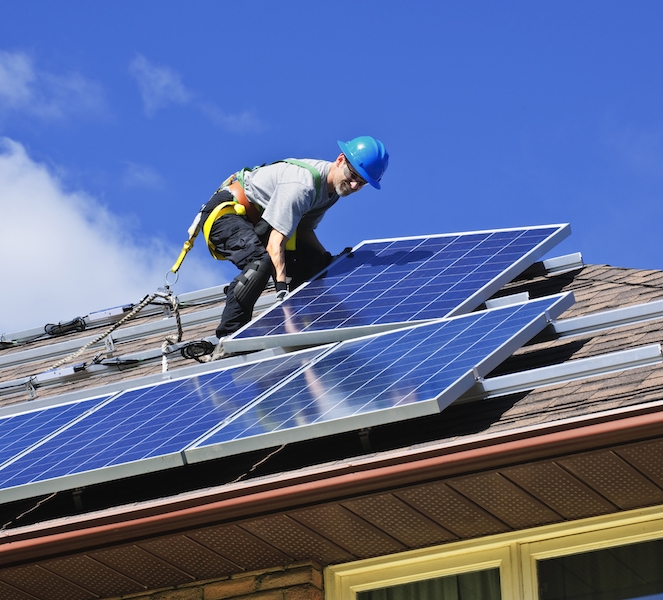
Features
Safety
Working safely with photovoltaic generation systems
December 11, 2018 | By Mark Elias
 Photo courtesy IHSA
Photo courtesy IHSADecember 11, 2018 – Photovoltaic (PV) solar panel systems have become increasingly popular in residential and commercial sites for providing a primary or backup source of electricity. With the proper hazard assessments and safe work practices, they present a safer option for power generation in comparison to traditional sources of electricity.
That said, the installation and maintenance of PV systems are categorized as high-risk work. The hazards associated with such work need to be recognized, assessed, controlled and, if possible, eliminated.
A duty for precaution
With the rapid growth of the PV industry, occupational hazards have increased for workers involved in installing and maintaining PV systems.
Under Ontario’s Occupational Health and Safety Act (OHSA), by way of example, employers have a duty to take every reasonable precaution to ensure supervisors and workers are aware of the hazards associated with the handling, use and transport of the equipment in PV systems. This duty applies whether systems are installed on the ground or a rooftop, at an industrial or residential site. And as part of that duty, it is important for employers to establish safe procedures.
One of the problems with new technology is the tendency for a mindset that the labour involved in its installation is somehow new as well, such that old safety procedures do not apply. In the case of PV systems, they are installed primarily on rooftops or on the sides of buildings, yet not all installers will be trained for working safely at heights.
Also, PV panels may seem harmless upon inspection, but they generate electricity at all times, except in complete darkness. So, anyone working in proximity to a PV panel must respect, understand and take precautions to avoid electrical contact.
Common hazards for PV system installation and maintenance include some of the most deadly known to the construction industry, including electrical contact shocks and burns, falls from heights, extreme weather-related hazards and musculoskeletal disorders (MSDs) related to material handling.
The need for training
Another common misconception suggests PV systems can be easily installed or maintained by a single worker. This leads to a temptation to carry out the work alone, which would nullify most emergency response plans in the case of an incident.
Another aspect to take into consideration is how PV panel installers and maintenance workers will not be the only ones working on and around the systems. Indeed, just about anyone working on a roof or a side of a building could be working in proximity to the panels and, thus, to their potential hazards; hence the need to put in place policies, procedures and additional training.
Such training may include the fundamentals of electrical hazards and controls, fall protection requirements, safe limits of approach to electric utilities, the use of personal protective equipment (PPE) and power tools, traffic planning and staging and the safe handling, hoisting and transportation of materials, ladders and other access equipment. There are specific hazards to understand before working on a sloped roof, at the edge of a roof and around skylights and roof openings, along with exposure to extremely hot, cold or windy weather. MSDs can be caused by poor lifting techniques and static postures. Pre-installation checks, emergency planning and first aid are all very important.
Implementing safe practices
With all of this in mind, Ontario’s Infrastructure Health & Safety Association (IHSA) and its roofers trade labour management health and safety committee recently established a new photovoltaic subcommittee to address concerns for those working on and in proximity to PV power generation systems. After identifying a need to educate employers and workers about these hazards, the subcommittee developed guidelines and published them as a new resource, titled ‘Safe Practices for Working On or Around Photovoltaic Systems.’
With training and education now readily available through such resources, electrical contractors and other professionals who work with or near PV systems can update their health and safety policies and safe work procedures accordingly. By completing a job safety analysis (JSA), they can address hazards early on, saving time and effort down the road, and they can equip their workers with the knowledge they’ll need to navigate PV system installation and maintenance safely.
Mark Elias handles media relations and communications for the Infrastructure Health & Safety Association (IHSA), based in Mississauga, Ont. For more information, including further details about ‘Safe Practices for Working On or Around Photovoltaic Systems,’ visit www.ihsa.ca.
This article originally appeared in the December 2018 issue of Electrical Business Magazine.
Print this page